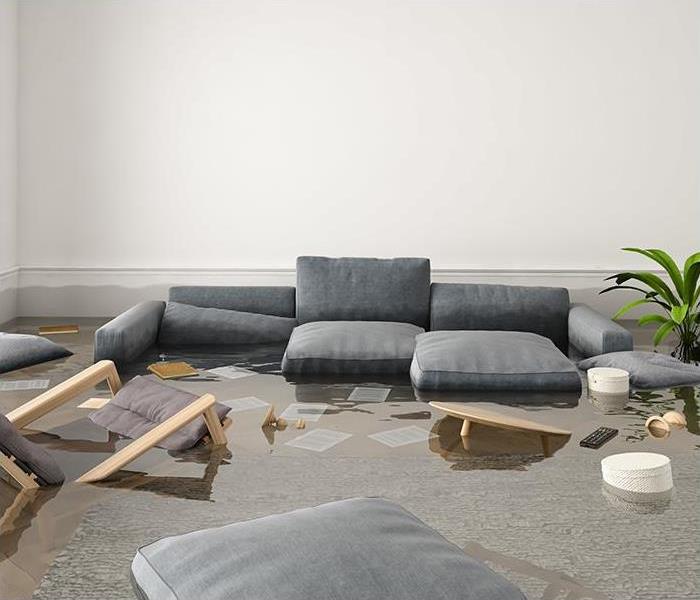Tips for Water Damaged Furniture
4/17/2019 (Permalink)
 Flood water is considered to be black water. Because of dangerous toxins and materials, it is recommended to throw these affected items away.
Flood water is considered to be black water. Because of dangerous toxins and materials, it is recommended to throw these affected items away.
Furniture that gets wet is not a pretty picture. Important questions that arise when you suffer from such a disaster in your home include: Can you save the furniture and how can you save it? The first critical step with any form of water damage involves determining the levels of risk factors in the contaminating water. This refers to the amount and types of pathogens that are found in the water. It is critical to make sure that a disease will not be contracted from exposure to the water.
The 3 Types of Contaminating Water
The first step is learning from which type of water your furniture has suffered damage. There are three types of water that can cause damage to your furniture. These are as follows:
- Category 1 - Clean Water - the drinkable water that comes from the regular pipes in your home. You could drink this, and it poses no threat to your family's health
- Category 2 - Grey Water - there are some contaminants found in greywater from either biological or chemical agents. These could be from the leakage of a water heater, an overturned fish aquarium, or an overflowing washing machine. While it will not kill you, you would not want to drink the water or get it in your eyes, which could easily burn on contact.
- Category 3 - Black Water - this is really nasty water including sewage or runoff from a river. It could make your family terribly ill. You should neither come into contact with it or even breathe the air surrounding the water.
How Furniture Items Can Be Cleaned
It is important to determine the water category to learn the proper path for cleaning the water damaged furniture. There are many cost-effective methods for treating the first and second categories of water damage. When black water has infected the furniture it usually cannot be saved. Methods of treating furniture vary according to whether it is wood or upholstered.
Wood Furniture
Wood suffers from water damage very quickly. When it is on a large scale it becomes more serious as wood furniture is tricky to fix. If you allowed the furniture to sit in water for several days, it is likely completely ruined and should be discarded. For one thing, the bindings or glue that hold it together may be irreparably damaged.
Yet even still it might be saved. You can take pieces apart to clean and dry them before putting them back together. The furniture will generally require re-stripping, bleaching, cleaning, drying out, and refinishing. This will be both a labor and time-intensive process. It is wise to get a cost estimate done before you start the project to ascertain if it makes more sense to restore an original piece or replace the furniture entirely.
Upholstered Furniture
Upholstered couches and chairs are sometimes tricky to dry and clean. The items may be pressure treated in a special way. Extremely high-temperature water will first kill off pathogens such as bacteria. After the furniture has dried properly it will be put in a room with a dehumidifier and air movers set up.
Such air movers will be strategically placed to move dry, hot air through and over the furniture. The moisture will evaporate, and the industrial dehumidifier will gather in the moisture. It will finally be released outside of the house.
There are circumstances where the upholstery has to be removed. These include when the water has soaked into the furniture over a long period of time. Cleaning, then a treating and drying process will reach the places that are hard to get to which have become water damaged.
When Items Should Be Disposed Of Finally
It is critical to realize that you can not hope to clean out water damaged furniture which has been soaked by the black category 1 water damage. There are cases where it could be sensible to try if the piece was very expensive (like with a Persian rug). The costs of trying to do this generally are far greater than simply replacing the items. This is true for most any kind of porous-surfaced furniture. The best plan is to take the black water damaged item and simply throw it away.
For furniture that is upholstered and heavily damaged by other categories of water, there are limited options. Fabric that has become watermarked or stained is difficult to completely restore. It is possible that after a few hours of soaking in water, silt and mud can penetrate the padding and fabric as well.
Padding also still holds in water even when the rest of the furniture appears dry. This is when mildew forms outside and inside. Wood that is finished will turn cloudy. The wood can mildew if the flood water manages to penetrate the finish. Joints within wood frames can also become loose. If the furniture was sewage-contaminated or has industrial chemicals or pesticides from the flood water within it, this is the time to throw away the upholstered or wood furniture and start over with new pieces.





 24/7 Emergency Service
24/7 Emergency Service